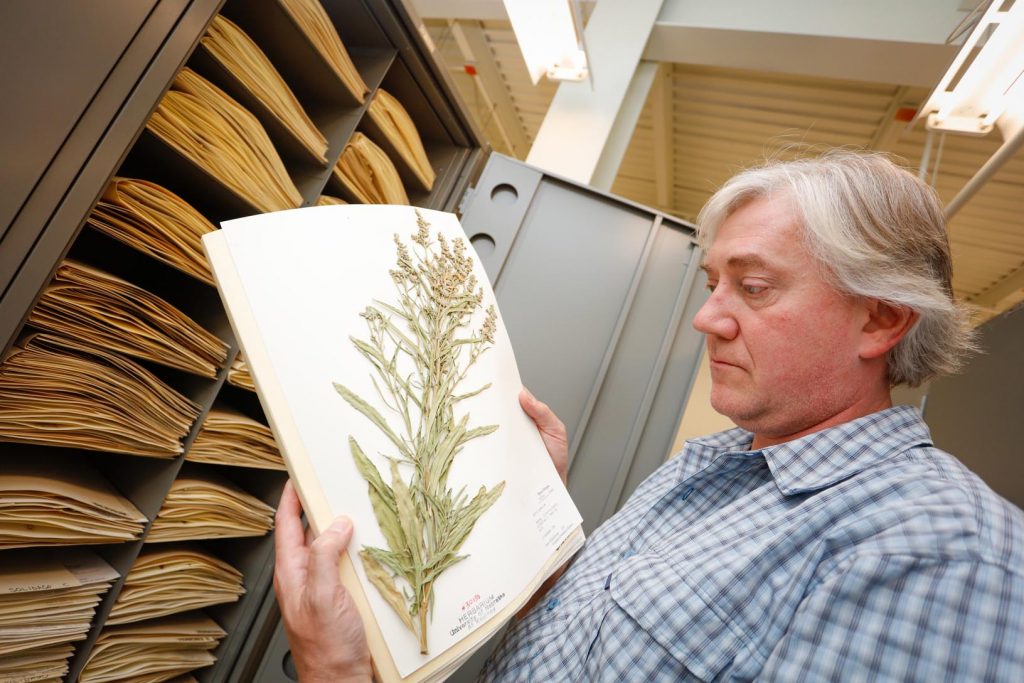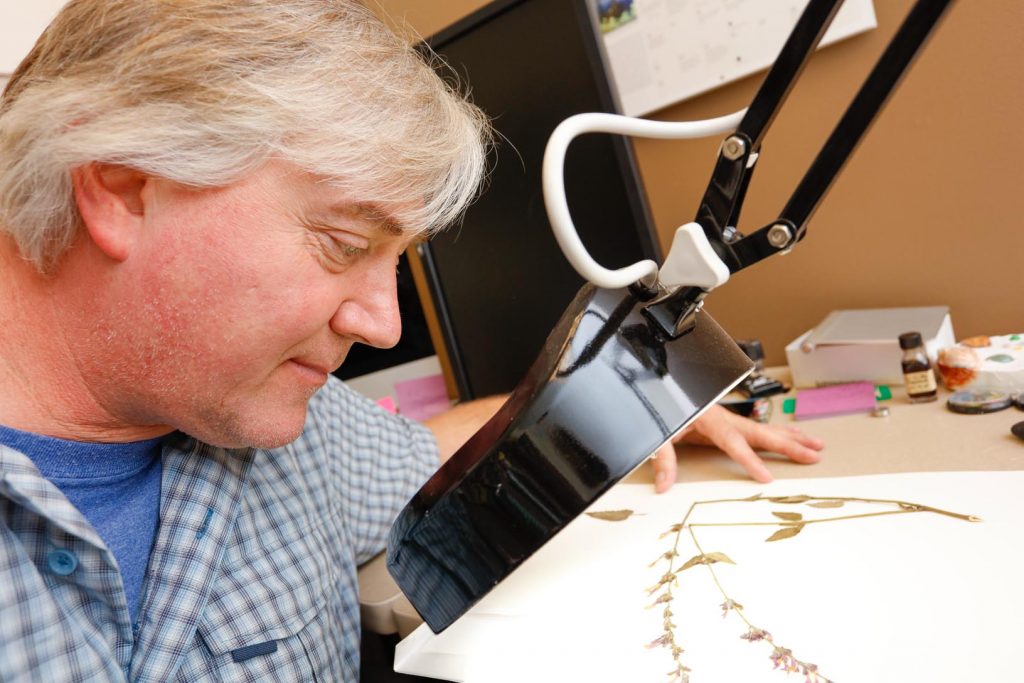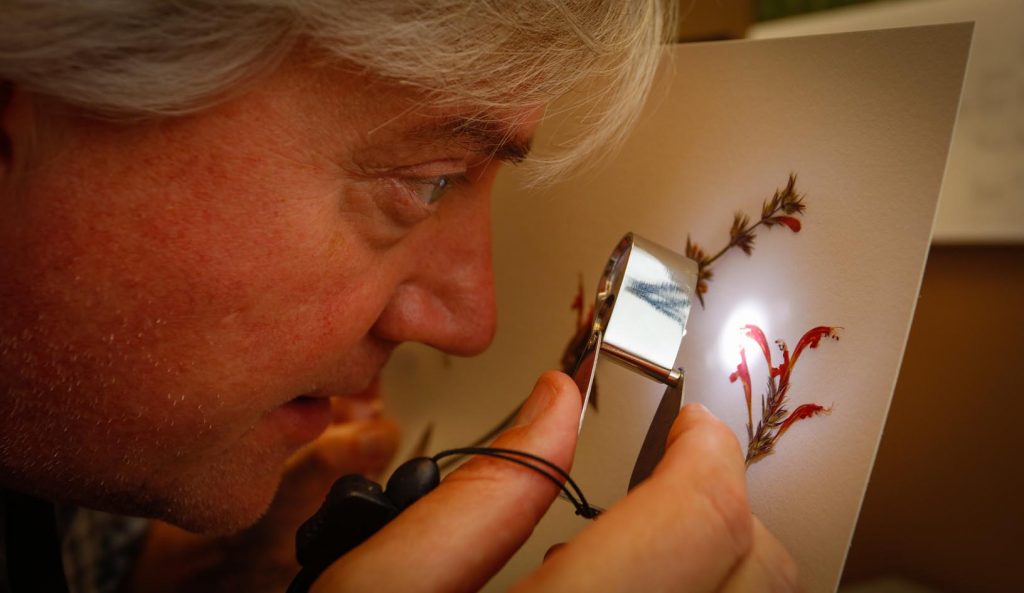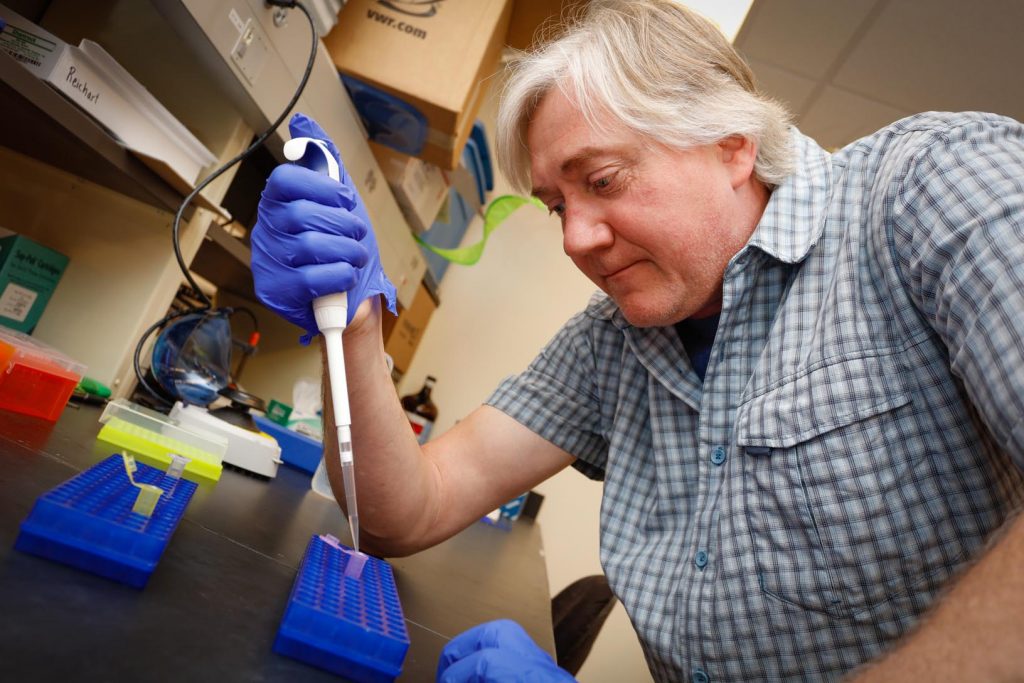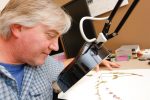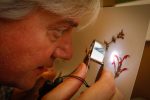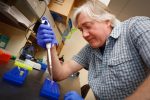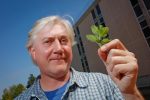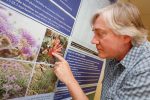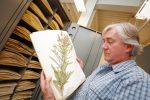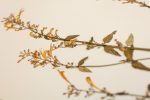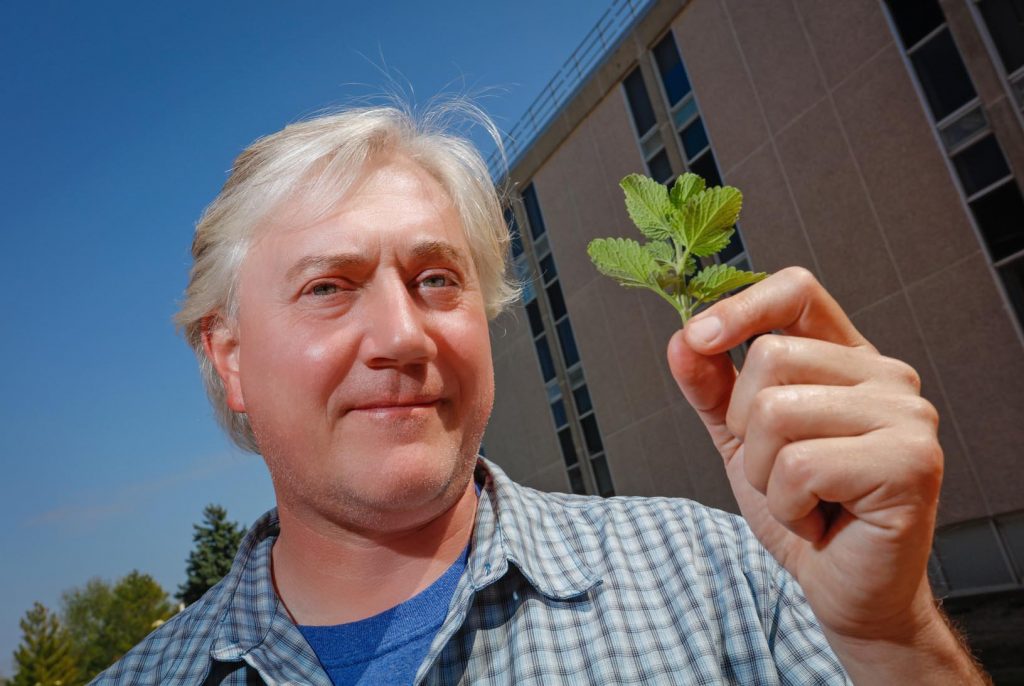 By KIM HACHIYA
By KIM HACHIYA
UNK Communications
Mints.
Those aromatic plants that brighten mojitos, tabbouleh and chewing gum, comprise one of the largest families of plants in the world. The mint family, known by its scientific name Lamiaceae, has about 7,000 members; they are found on all continents except Antarctica. And they often are found in exceptionally scenic areas, or maybe in your backyard garden.
This widespread abundance of Lamiaceae is a big reason the plants are of intense interest to the horticulture industry. And they attract botanists such as Bryan Drew, assistant professor of biology at the University of Nebraska at Kearney.
Drew says, somewhat in jest but also with more than a whiff of seriousness, that his love of travel pushed him to choose the mint family for intense research. And his focus on one genus, Salvia, has led him worldwide in searching out its 1,000 members. That search has taken him all over the United States, Mexico, South America, and in the summer of 2017, Turkey, southeastern Europe and China.
Lamiaceae are known for their square stalks and simple, opposite leaves. Most have showy flowers and many have fragrant volatile oils prized for culinary or medicinal uses. Culinary herbs include mint, basil, rosemary, sage, oregano, thyme and lavender. Other members of the family are grown for their beauty, such as Coleus, Monarda, Salvia and Ajuga. Salvia yields edible seeds – chia. Even catnip is a member of this large family.
Drew, however, is interested in the plants’ backstory – the story of how and why they evolved and dispersed worldwide. Of the 250,000 or so known plant types worldwide, two percent are in the Lamiaceae family, which is the sixth largest plant family. Drew is interested in radiations of Lamiaceae – why and how this huge family diversified and created new species. Scientists know that Lamiaceae began to diversify about 66 million years ago after the KT (Cretaceous-Tertiary) extinction, when all of earth’s large animals such as dinosaurs, and many plants, went extinct, virtually overnight.
“Extinctions wipe the slate clean,” Drew said. “That opens new ecological niches. New things become dominant.”
Changes in climate favored the rise of Lamiaceae. They thrive best in open areas where they don’t compete with dense shrubs or trees. They like slopes and hills, and cooler, drier climates. Often these plants thrive in landscapes that are not conducive to farming. The diversification in the family coincided with the rise of flying things that would pollinate the flowers.
Pollination is the process through which pollen (plants’ sperm) from stamens transfers to the stigma, the external female reproductive organs of plants, enabling fertilization and the production of seeds in the plants’ ovaries. Some plants are pollinated by wind, others by insects, birds or even animals. Insect pollinators for Lamiaceae included bees in Africa, Asia and Europe, and the Americas. Avian pollinators such as hummingbirds came later, starting about 25 millions years ago, in North and South America. Bird pollination is almost exclusive to the New World, Drew said. In any event, both birds and bees are attracted to flowers.
Lamiaceae flowers are generally double lipped – the plants used to be called Labiatae, derived from the Latin word for lips, labia – with open mouths, tubular corollas (petals) and five-lobed bell like calyxes (sepals). Scientists believe
that flowers diversified and adapted to accommodate and take advantage of pollinators’ needs. Some plants are so specialized that only one type of pollinator can effectively pollinate them.
“One of the coolest things about Salvia, one of the unique things, is they have this staminal lever mechanism,” Drew said. “They have two stamens, and each stamen has two pollen sacs (theca). One theca is fertile, the other is usually infertile. Functionally, a bee or bird hits the infertile portion and it pivots the fertile portion onto the head or abdomen of the bee or bird. This lever sits in the flower in such a way that to get to the flowers’ nectar, the pollinator must hit it.”
When the pollinator moves to another flower, it carries pollen to it, fertilizing that flower and picking up a new pollen load.
“This type of pollination process promotes outcrossing among flowers and increases fitness,” Drew said. “But the levers are often specific to specific pollinators, which maintains species boundaries.”
These levers are unique to Salvia, Drew said.
“Typically in a big genus, there are special and unique attributes or ‘key innovations’ that set them apart and favors them over others. This lever mechanism is it for Salvia.”
Although Salvia are among the most numerous members of the Lamiaceae family, with some 1,000 species, they are a relatively young genus – maybe 35 million years old in the Old World, and just 10 million years old in the New World. Because of its relative youth, there are not a lot of genetic mutations, which allow scientists to examine relationships and divergences.
Drew and his colleagues are parsing the evolutionary story. They are identifying which pollinators are specific to which Salvia species and trying to correlate underrepresented bees with particular Salvia. Did bee evolution correlate with mint evolution? It is possible that certain bee groups diversified, he said, as the mint group diversified.
The botanists are also interested in how chemistry is correlated with diversification in Salvia. They note, for example, that the particular smell of mint repels insects from eating the plants.
The way to fill in the blanks is to collect and study plants.
Drew and a colleague from the University of Wisconsin, Ken Sytsma, are co-principal investigators on a $1 million grant from the National Science Foundation to focus on Salvia. Drew and Sytsma note that the staminal lever mechanism of Salvia originated independently three different times within Salvia. This makes the genus an interesting model to study how key innovations led to diversifications in different areas of the world. They propose to collect specimens from about 700 known Salvia species and subject them to “next generation sequencing” to infer relationships between the species to determine when, where and how the various species diverged and developed.
The physical collection of specimens has taken Drew worldwide, including the 2017 trips to Turkey and China.
Because Salvia tend to grow in remote areas, collection trips can turn into scenic adventures. Typically, he said, he starts with information from herbaria consortia and sorts by dates when plants likely will be blooming. He goes to the sites, rents a vehicle, taxi or sometimes has hitchhiked to likely locales. And then he just looks around.
Once species are found, he will take full specimens by the roots if possible, or perhaps just a few branches or stems, and labels the specimen as to date, time, place, type, etc. in a field notebook. In a perfect world, the plants are deposited in herbaria within the local country, at Wisconsin, at UNK and sometimes at University of California-Berkeley. Leaves from the plants are placed with a desiccant pack of silica into a cellophane envelope and then into a plastic bag, again well labeled. He takes leaves for DNA extraction and seeds for garden experiments.
An important part of the project is photographing and making high-resolution scans of the images, in the field if possible to avoid wilt and to capture the specimens at peak freshness. He scans flowers, leaves and sex parts against both black and white backgrounds and from varying angles and positions. Later, he uses software to correlate floral features to assess which flower components may be responsible for the kind of diversification that has made Salvia such a successful group of plants.
“The flowers are so delicate. They wilt quite quickly,” Drew said. “The goal sometimes is to get them into a cooler to extend their life, but scanning in the field is ideal. It can take about 20 to 30 minutes to fully scan each flower.”
Drew and another Wisconsin colleague, Ricardo Kriebel, have made an attractive poster of flowers the two have scanned at UC-Berkeley Botanical Garden. The flowers at the top of the poster are blue, and they gradually move to pink and red. Blue flowers, Drew notes, are bee pollinated, and pink and red flowers are bird pollinated.
The most surprising find for Drew occurred in 2008 when he and colleague Ivalú Cacho were searching in Mexico for a plant not part of the Salvia group (but still a mint) called Neoeplingia. That plant was first described in 1982, but it had never had its DNA sequenced, and is only known to come from one place in the world.
It is endemic to the State of Hidalgo in Central Mexico, and there is only one known species in the genus, Neoeplingia leucophylloides. Drew and Cacho spent three days searching in a beautiful area near the Barranca de Tolantongo, but they were searching in the wrong place. They finally found it by inquiring about the plant at a small courthouse, and found the location of the plant was actually near a bus stop, which had the pet name Molanguito (little hill) locally, and not near the spot on their map marked Molanguito. Somewhat surprisingly, the plant ended up being a part of the genus Drew was studying for his Ph.D., Lepechinia.
“It was a total surprise. It was fun. It was quite a saga,” he said. Neoeplingia leucophylloides’ DNA figured prominently in Drew’s doctoral dissertation, which he earned in 2011 from Wisconsin-Madison. He is entering his fourth year at UNK.
Drew became interested in Salvia because his dissertation work was on a closely related plant and Salvia are “big, low-hanging fruit in terms of research possibilities.” Another scientist in the Wisconsin lab, Jay Walker, had been working with Salvia for more than 20 years and had a large body of research, Drew said. Walker decided to change careers from research to high school teaching, and he turned his work over to Drew.
The NSF project is funded for three years. In addition to adding to the scientific knowledge of Salvia, the research team has put together an international group of Salvia “enthusiasts,” and the team will host a world Salvia Summit IV in the coming years. Three have been held so far and each attracts 80 to 100 people, most from the horticulture industry. In addition, they will present or host scientific/academic symposia where outcomes will be discussed. They also hope to help preserve and conserve Salvia species through deposits in U.S. and foreign botanical gardens and herbaria.
A website hosted by the Wisconsin State Herbarium will be upgraded and enhanced; the team believes it will help gardeners and horticulturists find potential Salvia for landscape uses and to encourage use of these plants to aid pollinators, many species of which have been struggling as habitats degrade.
Drew said the project will employ undergraduate and graduate scientists. They also envision developing undergraduate field courses.
A native of Illinois, Drew did his undergraduate work in botany at California-Berkeley, earning a B.S. in 1996. He spent a number of years traveling, and working for AmeriCorps, the U.S. National Park Service and Forest Service in California before returning to school to earn his doctorate.
 BRYAN DREW
BRYAN DREW
Title: Assistant Professor, Biology
College: Natural and Social Sciences
Education: Associate in Arts, College of the Siskiyous, 1994; Bachelor of Science, Forest Ecology, University of California, Berkeley, 1996; Graduate Studies, Utah State University, 2002; Doctor of Philosophy, Systematic Botany, University of Wisconsin-Madison, 2011.
Years at UNK: 3
Non-Academic Career: Wetland ecologist, Wisconsin Department of Natural Resources, 2011-12; Contract botanist, Ottawa (Mich.) National Forest, 2008-09; Biological technician, U.S. Forest Service, Klamath National Forest, 2002-05; Biological technician, Pinnacles National Monument, 2004; Biological technician, U.S. Forest Service, Teakettle Experimental Forest, 2003; Service volunteer, AmeriCorps Watershed Stewards Project, 2000-01; Timber cruiser, Natural Resource Management, Eureka, Cal., 1999.
Research Assistantships: Department of Botany, UW-Madison, 2007 and 2010-11; Soil Nutrient Cycling, Smoky Mountain National Park, 2002; Soil Nutrient Cycling, Utah State University, 2002.
Teaching Assistantships: Survey of Botany, Dept. of Botany, UW-Madison, 2010; Introductory Biology, Dept. of Zoology, UW-Madison, 2009; Vegetation of Wisconsin, Dept. of Botany, UW-Madison, 2009; Flora of Wisconsin, Dept. of Botany, UW-Madison, 2009; Dendrology, Dept. of Botany, UW-Madison, 2008; Flora of Wisconsin, Dept. of Botany, UW-Madison, 2008; Vegetation of Wisconsin, Dept. of Botany, UW-Madison, 2007; Plant Biogeography, Dept. of Botany, UW-Madison, 2007; Plant Systematics, Dept. of Botany, UW-Madison, 2006; Vegetation of Wisconsin, Dept. of Botany, UW-Madison, 2006; Flora of Wisconsin, Dept. of Botany, UW-Madison, 2006; Plant Systematics, Dept. of Botany, UW-Madison, 2005.
Hobbies/Interests: Traveling, botanizing, hiking, camping, reading
Honors/Awards: Courtesy Faculty, University of Florida, 2014-present; Honorary Research Fellow, Department of Botany, UW-Madison, 2013-present; ON and BK Allen Fellowship, Department of Botany, UW-Madison, spring 2010; Newcomb Summer Research Fellowship, Department of Botany, UW-Madison, summer 2008.
Areas of research/specialization: Phylogenetics and evolution of the Lamiaceae, especially the genera Agastache, Lepechinia, Monardella and Salvia; Temporal and spatial origin of the California Floristic Province flora; Plant speciation processes in Western North America; Pollination biology; Conservation genetics; Salmon habitat restoration; River and stream rehabilitation
Courses taught: Natural History of the Southwest, Insect Biology, The Six Global Mass Extinctions, Scientific Communication, Introduction to Soil, Flowering Plants: Systematics and Evolution, Plant Diversity and Evolution, Plant Taxonomy, Plant Ecology
Recent Published Articles:
- “Salvia United: The Greatest Good for the Greatest Number,” Taxon, 2017.
- “Synthesis of Phylogeny and Taxonomy Into a Comprehensive Tree of Life,” Proceedings of the National Academy of Sciences, 2015.
- “Another Look at the Root of the Angiosperms Reveals a Familiar Tale,” Systematic Biology, 2014.
- “Lost Branches on the Tree of Life,” Plos Biology, 2013.
- “Phylogenetics, Biogeography, and Staminal Evolution in the Tribe Mentheae (Lamiaceae),” American Journal of Botany, 2012.
-30-
